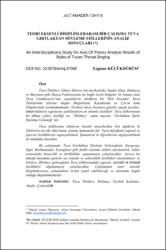Teori eksenli disiplinler arası bir çalışma tuva gırtlaktan söyleme stillerinin analiz sonuçları
Abstract
Tuva Türkleri, Güney Sibirya’nın merkezinde; bugün Altay, Hakasya
ve Buryatya gibi Rusya Federasyonu’na bağlı özerk bölgeler ile komşu olan
Tuva Cumhuriyeti’nde yaşamlarını sürdüren bir Türk boyudur. Tuva
Türklerinin izlerine bugün Moğolistan, Kazakistan ve Çin’in kimi
bölgelerinde rastlanmaktadır. Tarihsel süreç boyunca göçebe yaşam tarzları,
sosyo-kültürel yapılarını şekillendiren en önemli özelliktir. Tuva folklorunun
en dikkat çekici özelliği ise “Höömey” adını taşıyan “Gırtlaktan Şarkı
Söyleme Geleneği”dir.
Tuva folklorunu etkileyen önemli unsurlardan biri şüphesiz ki
Türklerin en eski ilkel inanç sistemi Şamanizm’dir. Tuva müziğinin yapısal ve
işlevsel özelliklerini saptayabilmek, Şamanizm’in öğretilerini algılayabilmek
ile mümkün olacaktır.
Bu çalışmada, Tuva Gırtlaktan Söyleme Geleneğinin, Kargıraa,
Sıgıt, Borbannadır, Ezengileer gibi farklı söyleme stilleri incelenerek, stiller
arasındaki benzerlik ve farklılıklar saptanmaya çalışılacaktır. Ayrıca bu
müziği meydana getiren ses sistemi ve çokseslilik özellikleri incelenmeye ve
böylece Höömey geleneğinin Tuva folklorundaki yapısal, işlevsel ve icrasal
özellikleri algılanmaya çalışılacaktır. Çalışmanın teori eksenli
disiplinlerarası çalışmalara örnek teşkil edebileceği ve alanında özgün
olduğu düşünülmektedir. Tuva Turks are Turkic Clan who lived in Republic of Tuva from the
center of South Siberia and neighbor to autonomous territories in Russian
Federation like Altai, Khakassia, Buryatia. Today, Tuva Turks can be seen in
some regions of Mongolia, Kazakhstan and China. The most important
feature is their nomadic lifestyles which has influence on their socio-cultural
structures throughout the historical process. The most striking feature of the
Tuvan folklore is the “Tradition of Throat Singing” which is the name of the
“Khöömei(Xöömei)”.
One of the most important elements which influences the Tuvan
folklore is the earliest primitive belief system of the Turks is Shamanism. To
identify the structural and functional characteristics of Tuva music will be
possible by perceiving the teachings of Shamanism.
In this study, similarities and differences between the styles will be
tried to be determined by examining the different singing styles such as Tuva
Throat Singing Tradition, Kargıraa, Sıgıt, Borbannadır, Ezengileer. In
addition, the sound system and polyphonic features that bring this music to
the genre will be examined so that the structural, functional and practical
features of the Khöömei(Xöömei) tradition in the Tuva folklore will be
perceived. It is thought that the work can be an example of an
interdisciplinary study on axis of theory and is original in its field.
Source
Akademik Müzik Araştırmaları Dergisi “AMADER”Volume
4Issue
8URI
http://amader.aku.edu.tr/wp-content/uploads/2018/07/13.-Ezginur-K%C3%BC%C3%A7%C3%BCkd%C3%BCr%C3%BCm_c4s8.pdfhttp://hdl.handle.net/11630/5072
Collections
- Cilt 4 : Sayı 8 [7]



















